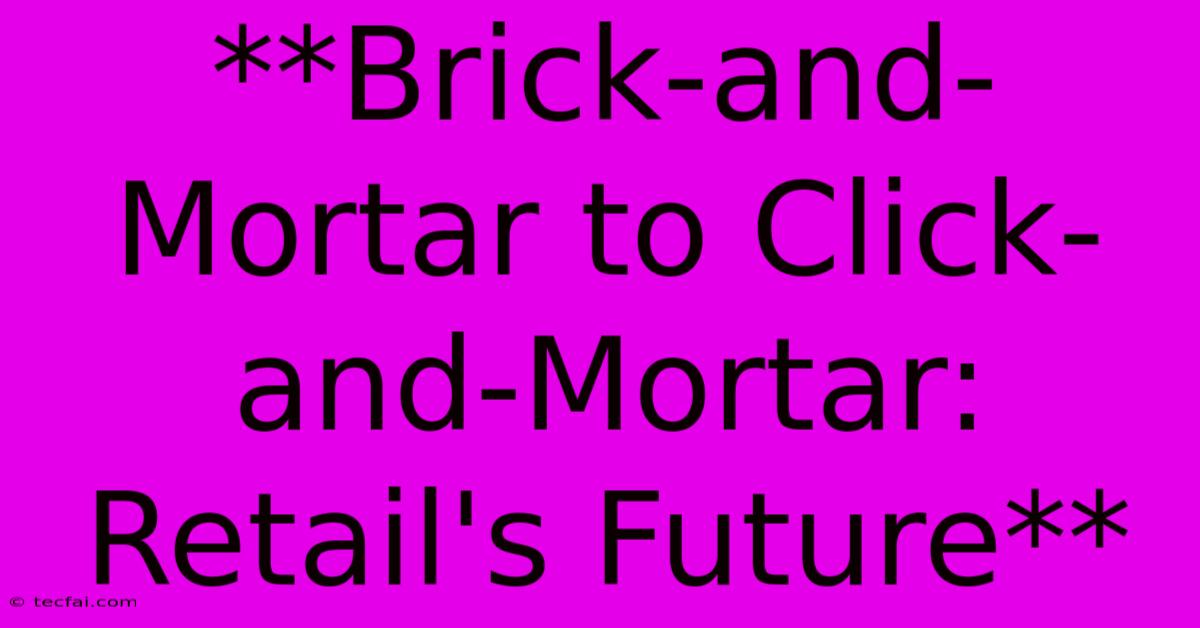**Brick-and-Mortar To Click-and-Mortar: Retail's Future**

Discover more detailed and exciting information on our website. Click the link below to start your adventure: Visit Best Website tecfai.com. Don't miss out!
Table of Contents
Brick-and-Mortar to Click-and-Mortar: Retail's Future
The retail landscape is in constant flux. What was once dominated by brick-and-mortar stores has been significantly disrupted by the rise of e-commerce. However, the future of retail isn't solely about online dominance. It's about a seamless blend of physical and digital experiences – the rise of click-and-mortar.
The Shift from Brick-and-Mortar to Click-and-Mortar
The traditional brick-and-mortar model relied on customers physically visiting stores. This meant high overhead costs for rent, utilities, and staffing. The rise of e-commerce offered a cost-effective alternative, eliminating the need for physical locations and reducing overhead. However, this transition also presented challenges.
Consumers missed the tangibility of products, the ability to try before they buy, and the personalized service offered by brick-and-mortar stores. This gave rise to click-and-mortar, a hybrid model that combines the best of both worlds.
The Click-and-Mortar Revolution
Click-and-mortar businesses leverage both online and offline channels to cater to the evolving needs of consumers. Here are some key features of this model:
1. Enhanced Customer Experience:
- Omnichannel Shopping: Consumers can browse products online, order them online or in-store, and choose their preferred delivery or pick-up options.
- Personalized Recommendations: Online data can be used to provide personalized product recommendations and offers based on individual customer preferences.
- Interactive In-store Experiences: Augmented reality, virtual reality, and interactive displays enhance the shopping experience and provide valuable information about products.
2. Strategic Integration:
- Inventory Management: Click-and-mortar businesses can leverage data analytics to optimize inventory levels and ensure products are available across all channels.
- Fulfillment Flexibility: Customers can choose to pick up online orders in-store, enjoy same-day delivery, or opt for traditional shipping.
- Customer Service Integration: Online and offline customer service teams collaborate seamlessly to provide consistent support.
3. Data-Driven Insights:
- Customer Behavior Tracking: Data collected through online interactions and in-store transactions provides valuable insights into customer preferences, allowing businesses to personalize their offerings and tailor marketing strategies.
- Performance Analytics: Data analysis helps businesses optimize pricing, promotions, and inventory management for improved profitability.
- Market Trends Identification: Understanding customer behavior and market trends through data analysis helps businesses adapt to changing consumer preferences and stay ahead of the competition.
The Future of Retail: Embracing the Click-and-Mortar Model
The future of retail lies in embracing a click-and-mortar approach. This means:
- Investing in technology: Implementing online platforms, integrating inventory systems, and adopting new technologies to create seamless customer experiences.
- Focusing on customer experience: Providing personalized services, convenient options, and engaging in-store experiences.
- Leveraging data insights: Using data to understand customer preferences, optimize operations, and stay ahead of market trends.
By seamlessly integrating online and offline channels, businesses can provide customers with a convenient, personalized, and engaging shopping experience. This is the key to success in today's dynamic retail landscape.
The click-and-mortar model is not just a trend but a necessary evolution in retail. It empowers businesses to leverage the best of both worlds, offering customers the flexibility and convenience they desire while staying relevant in a rapidly changing market.

Thank you for visiting our website wich cover about **Brick-and-Mortar To Click-and-Mortar: Retail's Future** . We hope the information provided has been useful to you. Feel free to contact us if you have any questions or need further assistance. See you next time and dont miss to bookmark.
Featured Posts
-
Gunfire Strikes Spirit Flight Approaching Haiti
Nov 12, 2024
-
California Men United Patriotism And Weathered Flag
Nov 12, 2024
-
Megan Fox Pregnant First Child With Mgk
Nov 12, 2024
-
Ozs Downfall Penguins Use Of Vic
Nov 12, 2024
-
Free Paddington 1 And 2 Prepare For The New Film
Nov 12, 2024
